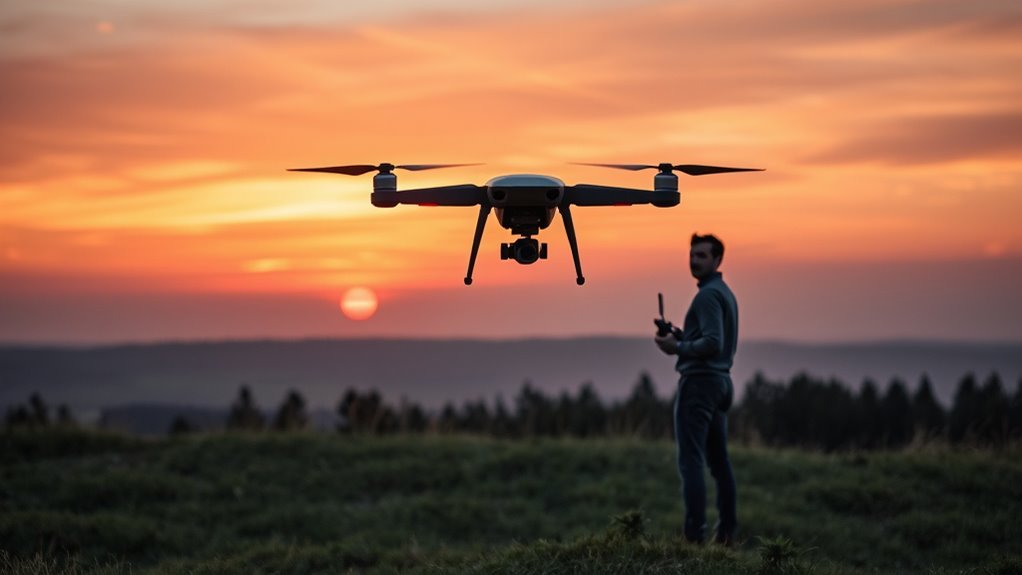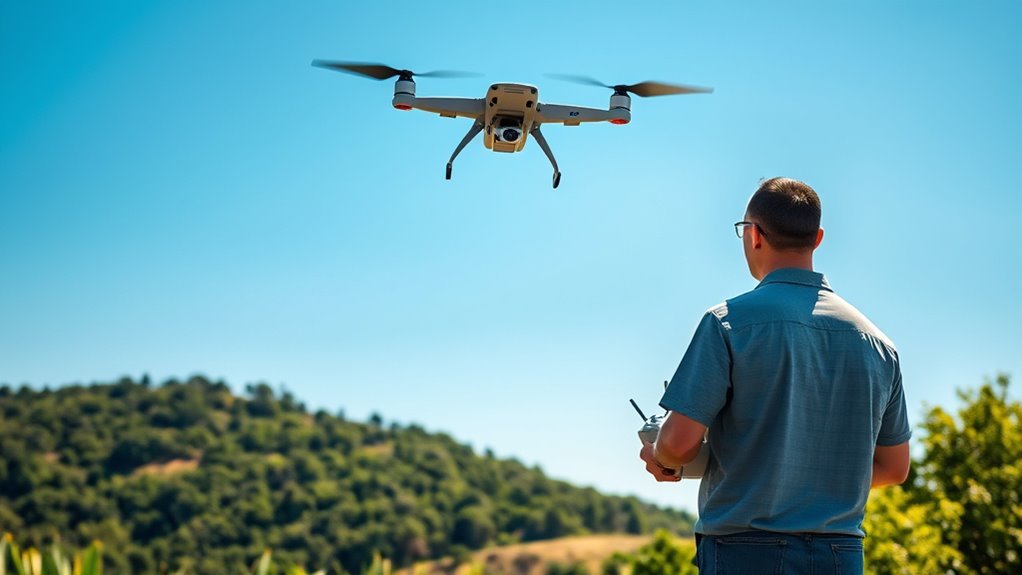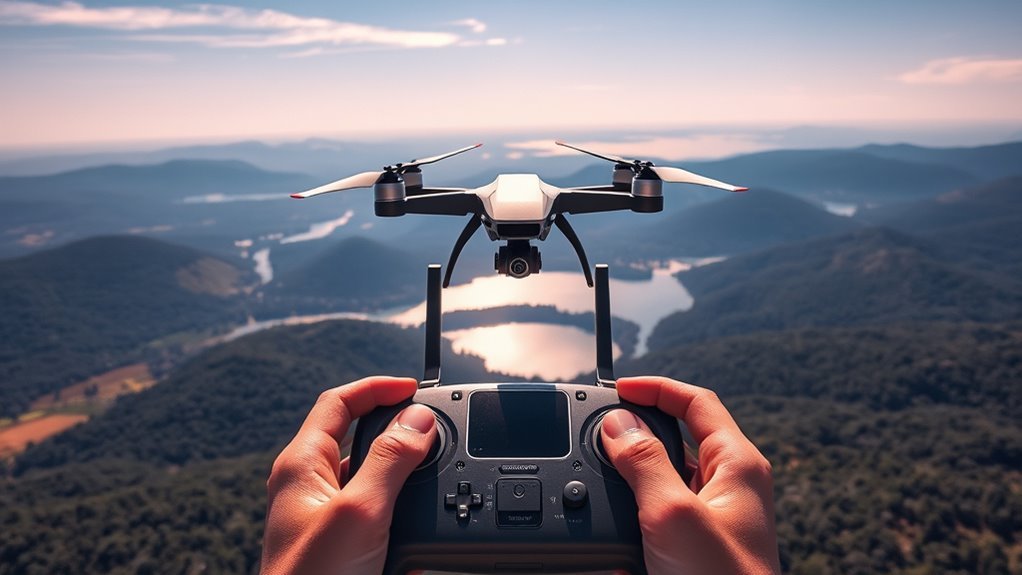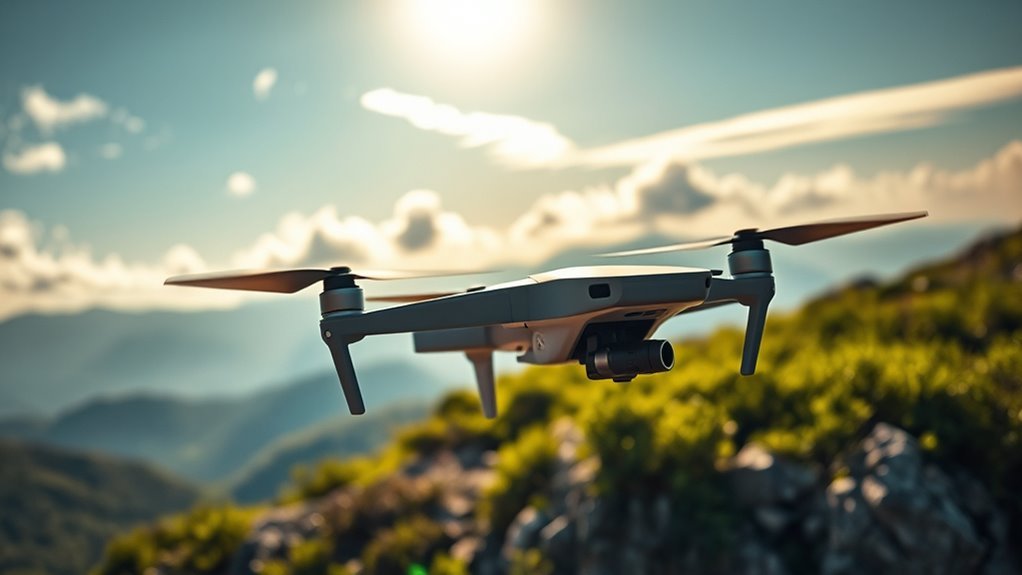The distance a drone can fly from its controller is influenced by several factors. These include communication technology using frequency bands like 2.4 GHz and 5.8 GHz, antenna design, battery life, and power output. Environmental conditions, such as weather and obstacles, play a critical role too. Additionally, local regulations, particularly line of sight rules, affect operational limits. Understanding these aspects will enhance your flying experience and optimize your drone’s capabilities. There’s more to explore on this topic.
Drone Communication Technology

As drone technology evolves, the importance of robust communication systems becomes increasingly evident. Effective drone protocols are essential for ensuring seamless data exchange between the drone and its operator. You’ll find that communication latency directly impacts the responsiveness of your drone, affecting its ability to navigate complex environments. High latency can lead to delays in command execution, risking flight safety and operational efficiency. By implementing advanced communication systems, you can minimize latency, allowing for real-time adjustments and enhanced control. Additionally, a solid understanding of existing drone protocols can empower you to optimize flight distances, ensuring your drone operates within its maximum range while maintaining reliable connectivity. This is particularly crucial as most drones operate on 2.4 GHz and 5.8 GHz frequency bands, which are vital for balancing range and data throughput. Embracing these technological advancements allows for greater autonomy and freedom in drone operations, particularly in environments that require advanced collision avoidance capabilities to ensure safety and efficiency.
Frequency Bands Used

When you’re considering the flight distance of your drone, the frequency bands used for communication play an essential role. The radio frequency range directly impacts the signal strength and susceptibility to interference, which can limit your drone’s operational range. Understanding these factors can help you optimize your drone’s performance and extend its flight capabilities.
Radio Frequency Range
The radio frequency range plays an essential role in determining a drone’s flight distance. Different frequency bands impact how well your drone maintains a connection with the controller through effective signal propagation. Here are some key aspects to evaluate:
- 2.4 GHz Band: Offers longer range but can be crowded.
- 5.8 GHz Band: Provides higher data rates with shorter range.
- Signal Loss: Higher frequencies often face more attenuation.
- Interference: Other devices can disrupt radio frequency signals.
- Environmental Factors: Obstacles like buildings and trees affect signal strength.
Understanding these factors will help you choose the right frequency for your drone, ensuring you maximize its operational range while enjoying the freedom of flight.
Interference and Signal Strength
Signal strength and interference greatly influence a drone’s operational range, particularly when considering the frequency bands used for communication. You’ll often find that certain bands, like 2.4 GHz, are more susceptible to signal degradation due to interference sources such as Wi-Fi networks, microwaves, and other electronic devices. This interference can reduce your drone’s effective range, making it essential to choose the right frequency for your flight environment. Higher frequency bands, while offering faster data rates, can also be more easily obstructed by physical barriers. Understanding these dynamics helps you mitigate interference and optimize signal strength, allowing you to enjoy greater freedom in your drone operations. Prioritize clean airwaves to enhance your overall flying experience.
Environmental Interference

Although often overlooked, environmental interference plays an essential role in determining the effective flight distance of drones. Various environmental factors can lead to signal degradation, impacting your drone’s control and range. Understanding these elements can help you optimize your flying experience.
- Obstacles: Trees, buildings, and other structures can obstruct signals.
- Weather conditions: Rain, snow, or fog can disrupt communication. Additionally, extreme temperatures can lead to diminished battery efficiency, which affects overall flight distance.
- Electromagnetic interference: Nearby electronic devices can cause signal loss.
- Terrain: Hilly or uneven landscapes can impede line-of-sight.
- Temperature: Extreme heat or cold can affect drone performance. Additionally, weather conditions such as wind resistance can significantly increase power consumption, further reducing the effective flight distance.
Drone Type and Model
When choosing a drone, the type and model heavily influence its flight distance capabilities. Different drone specifications, such as radio frequency technology and antenna design, determine how far you can operate your drone from the controller. For instance, consumer-grade drones typically use 2.4 GHz systems, which may offer a range of several kilometers, while racing drones often utilize 5.8 GHz for lower latency but shorter distances. Model differences also play a significant role; high-end models often incorporate advanced transmission systems that enhance range and reliability. Additionally, understanding signal strength is crucial as it directly impacts the operational range of your drone. If you prioritize freedom in your aerial exploration, understanding these distinctions is vital for selecting a drone that meets your long-distance flying ambitions. Always compare specifications carefully to guarantee peak performance. Additionally, drones like the EXO Blackhawk 3 offer advanced transmission systems that significantly extend flight range compared to budget models.
Battery Life and Power Output
Battery life and power output are critical factors that directly impact a drone’s flight distance. Understanding these elements can help you maximize your drone’s range and performance. Here are key considerations:
Battery life and power output significantly influence your drone’s flight distance and overall performance.
- Battery capacity: Higher capacity means longer flight times.
- Power consumption: Efficient drones use less power, extending their range.
- Weight: Heavier batteries increase power needs but can also offer more capacity.
- Flight mode: Certain modes consume more power, affecting overall distance.
- Environmental factors: Wind resistance can increase power consumption, reducing battery efficiency. Additionally, the extended flight time provided by advanced battery optimization techniques allows for longer distances without interruptions, ensuring better performance during flights.
The battery life and power output play a crucial role in determining how effectively a drone can maintain its speed and stability during flight.
Altitude and Flight Conditions
The efficiency of a drone’s flight is not solely determined by its battery life and power output; altitude and flight conditions play significant roles as well. Altitude effects can drastically impact a drone’s performance. At higher elevations, thinner air can reduce lift, making it harder for your drone to maintain stability and distance. Additionally, varying flight conditions, like wind speed and temperature, can influence how far your drone flies. Wind can push your drone off course, reducing effective range, while extreme temperatures can affect battery efficiency. Understanding these factors allows you to optimize flight paths and enhance operational freedom. By accounting for altitude and flight conditions, you can maximize your drone’s capabilities and explore further than ever before. Moreover, being aware of environmental factors affecting range can help you anticipate challenges and plan accordingly. Furthermore, wind conditions can significantly impact power consumption and stability, affecting overall flight range.
Line of Sight Regulations
Although many drone operators prioritize maximizing flight distance, adhering to line of sight regulations is essential for safe and compliant operations. These regulations guarantee that you maintain visual contact with your drone, enhancing flight safety and minimizing risks. Here are key considerations:
- Guarantees situational awareness
- Reduces collision risks
- Facilitates better decision-making in emergencies
- Complies with local laws
- Protects privacy rights of others
- Understanding drone registration requirements is vital to ensure you are following the necessary legal protocols.
Staying within line of sight not only keeps you accountable but also empowers you to enjoy the freedom of flying responsibly. Additionally, understanding federal aviation regulations is crucial as it ensures compliance with important operational guidelines. Ignoring these regulations could lead to severe penalties or accidents, undermining the very liberties you seek. Prioritize line of sight for both your enjoyment and the safety of others in the airspace.
Antenna Design and Placement
Antenna type greatly impacts your drone’s flight distance, as different designs offer varying levels of signal range and reception quality. You’ll need to take into account placement optimization techniques to guarantee minimal interference and maximize signal strength. Understanding these factors is essential for achieving effective communication between the drone and its controller.
Antenna Type Impact
When considering how far a drone can fly, the type and placement of its antenna play an essential role in determining signal strength and range. The choice of antenna materials greatly influences performance, while antenna gain affects the ability to transmit and receive signals effectively.
- Higher gain antennas can extend the range.
- Directional antennas focus signals in one direction, enhancing distance.
- Omnidirectional antennas provide broader coverage but may reduce range.
- Lightweight materials can improve drone mobility without sacrificing performance.
- Properly designed antennas minimize signal loss and interference.
Understanding these factors helps you optimize your drone’s flight capabilities, granting you the freedom to explore greater distances while maintaining reliable control.
Placement Optimization Techniques
The effectiveness of a drone’s antenna can be greatly enhanced through strategic placement and design techniques. By employing ideal placement strategies, you can considerably improve signal strength and range. First, consider the height and orientation of the antenna; higher placements often reduce obstructions. Additionally, utilizing enhancement methods like polarization alignment can further increase efficiency.
Materials surrounding the antenna can also impact performance; avoid metal surfaces that may cause interference. Experimenting with different antenna types, such as omnidirectional versus directional, will also influence your flight distance. Finally, regular testing and adjustment of your setup will guarantee you’re maximizing your drone’s capabilities, allowing for greater operational freedom in various environments.
Upgrades and Modifications
Upgrading and modifying your drone can considerably enhance its flight distance and overall performance. By implementing strategic upgrade benefits and employing effective modification techniques, you can maximize your drone’s capabilities. Consider the following enhancements:
- High-capacity batteries for extended flight times
- Advanced antennas to improve signal strength
- Lightweight materials to reduce overall weight
- Firmware updates for optimized flight algorithms
- Propeller upgrades for better aerodynamics
These modifications not only boost your drone’s range but also its stability and control. Each upgrade or modification requires careful consideration of compatibility and potential impacts on flight dynamics, ensuring you achieve the desired results without compromising safety or functionality. With the right approach, your drone can soar to new heights of performance. Additionally, implementing lightweight materials can significantly enhance your drone’s portability and ease of handling, further contributing to its overall efficiency. Furthermore, selecting the right frequency band is crucial to maintaining reliable communication links, as it directly affects your drone’s signal quality and operational range.
Local Laws and Restrictions
Modifications can greatly enhance your drone’s flight capabilities, but understanding local laws and restrictions is equally important for safe and compliant operation. Each region has specific local regulations that dictate where and how you can fly. Failing to comply might not only limit your drone’s range but could also lead to fines or legal penalties. Airspace restrictions often involve no-fly zones near airports, military bases, or densely populated areas. Before you launch, it’s vital to research these regulations and verify your flight area’s status. Drones are powerful tools for exploration and creativity, but respecting the boundaries set by local authorities guarantees you maintain that freedom while operating responsibly and safely. Additionally, the potential for a US ban on DJI could further complicate compliance with local laws, emphasizing the need for awareness of geopolitical factors in drone operation. Always stay informed and fly within the law. Also, be aware of temporary flight restrictions that may apply to your flight area to ensure you are compliant with local regulations.
Frequently Asked Questions
How Do Weather Conditions Affect Drone Flight Range?
Imagine your drone battling a hurricane! Wind resistance can drastically cut your flight range, while temperature effects can either boost or diminish battery performance. Both factors play essential roles in determining how far your drone can soar.
Can I Increase My Drone’s Range With Software Updates?
Yes, you can often increase your drone’s range with software updates, as manufacturers may provide range enhancements. However, be mindful of software limitations that could also impact performance and regulatory compliance during extended flights.
What Role Do Drone Propellers Play in Flight Distance?
Drone propellers greatly impact flight distance. Proper propeller design enhances thrust, while propeller efficiency reduces energy consumption. By optimizing these factors, you can maximize your drone’s range, giving you more freedom in your aerial adventures.
Are There Specific Drones Best Suited for Long-Distance Flying?
If you’re seeking freedom in the skies, long-range drones with advanced endurance capabilities are your best bet. Models like the DJI Matrice series excel in distance, ensuring you capture breathtaking views far from your starting point.
How Does Drone Weight Influence Its Maximum Flight Range?
Drone weight considerably impacts maximum flight range, as heavier drones demand more power, reducing battery life. This increased weight compromises flight efficiency, limiting the distance you can effectively cover before needing to recharge or land.

